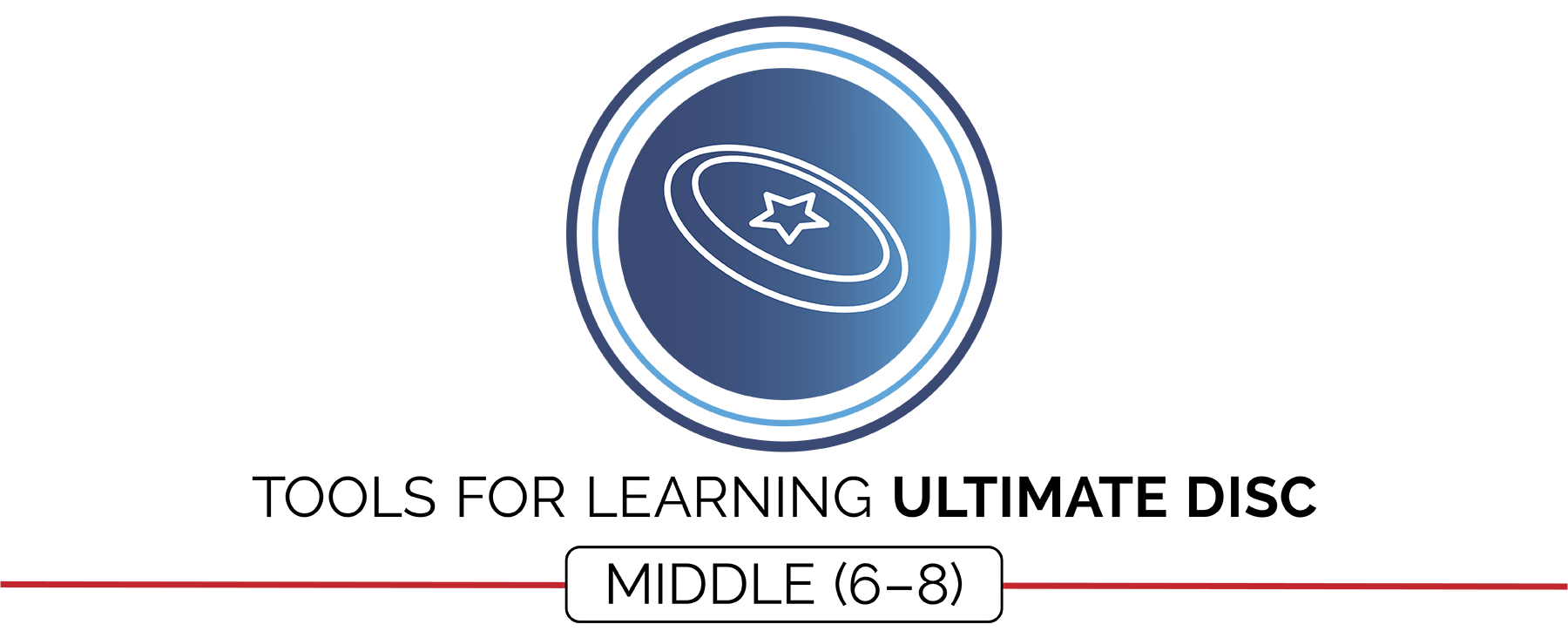Created by: Charla Tedder Krahnke, Victor Spadaro, Rich Wiles, Kate Darpino & Aaron Hart
Special Contributions: Deedi Brown & Kyle Gerken
Design: Jennifer Truong
The activities Hot Box and Goaltimate have been adapted from content created by USA Ultimate.
Ultimate is a noncontact invasion sport played with a flying disc. The sport was created in the 1960s by a group of high school students in New Jersey before spreading throughout North America — and the world. By 2010, there were over 5 million players in the United States alone.
One of the core concepts born within the Ultimate community is that of the Spirit of the Game (SOTG). From its inception until today, Ultimate has relied on self-officiating in order to make the game accessible in all communities. Self-officiating relies on SOTG as an overarching concept of sportsmanship and responsibility. Here’s an expert from the Official Rules of Ultimate: 11th Edition:
“Spirit of the Game. Ultimate relies upon a spirit of sportsmanship that places the responsibility for fair play on the player. Highly competitive play is encouraged, but never at the expense of mutual respect among competitors, adherence to the agreed-upon rules, or the basic joy of play.”
Module Documents
Complete Module Packet:
Module Overview:
Required Materials:
All Module Activities:
Sample Lesson Plan:
Academic Language Cards:
Ultimate Contest Station Cards:
Throwing Skill Cue Charts:
Catching Skill Cue Chart:
Ultimate Disc Rule Sheet:
Universal Design Adaptations:
Activity Plans
Toss-Up:
Throw and Go:
Fly Disc Baseball:
Uno, Dos, Tres:
Ultimate Contests:
Hot Box:
Goaltimate:
Mini-Ultimate:
Ultimate Disc:
Assessments
Holistic Performance Rubric:
Purposeful Practice Plan:
Spirit of the Game Exit Slip:
Academic Language Quiz:
Teacher Evaluation
Teacher Self-Evaluation/Reflection Guide:
Planning Tools
Blank Activity Plan Template:
Blank Lesson Plan Template:
Can’t see the file links? Register for FREE today to access all of the modules. SIGN UP HERE
National Standards and Outcomes Focus for Ultimate Disc
Standard 1.Demonstrates competency in a variety of motor skills and movement patterns.
- Standard 1 [M2.6-8]: Throws with a mature pattern for distance or power appropriate to the practice task (6); Throws with a mature pattern for distance or power appropriate to the activity in a dynamic environment (7); Throws with a mature pattern for distance or power appropriate to the activity during small-sided game play (8).
Standard 1 [M3.6-8]: Catches with a mature pattern from a variety of trajectories using different objects in varying practice tasks (6); Catches with a mature pattern from a variety of trajectories using different objects in small-sided game play (7); Catches using an implement in a dynamic environment or modified game play (8).
Standard 1 [M4.6]: Passes and receives with hands in combination with locomotor patterns of running and change of direction and speed with competency in invasion games such as basketball, fag football, speedball, or team handball (6).
Standard 1 [M5.6-8]: Throws, while stationary, a leading pass to a moving receiver (6); Throws, while moving, a leading pass to a moving receiver (7); Throws a lead pass to a moving partner of a dribble or pass (8).
Standard 2.Applies knowledge of concepts, principles, strategies and tactics related to movement and performance.
- Standard 2 [M2.6-8]: Executes at least one the following offensive tactics to create open space: moves to open space without the ball; uses a variety of passes; uses pivot, fake, or give & go (6); Executes at least two of the following offensive tactics to create open space: give & go; a variety of passes; fakes, pivot) (7); Executes at least three of the following offensive tactics to create open space: moves to create open space on and off the ball; uses a variety of passes, fakes, and pathways; give & go (8).
Standard 2 [M6.6-8]: Transitions from offense to defense or defense to offense by recovering quickly (6); Transitions from offense to defense or defense to offense by recovering quickly and communicating with teammates (7); Transitions from offense to defense or defense to offense by recovering quickly, communicating with teammates and capitalizing on an advantage (8).
Standard 3.Demonstrates the knowledge and skills to achieve and maintain a health-enhancing level of physical activity and fitness.
- Standard 3 [M7.6-8]: Identifies the components of skill-related fitness (6); Distinguishes between health-related and skill-related fitness (7); Compares and contrasts health-related fitness components (8).
Standard 4. Exhibits responsible personal and social behavior that respects self and others.
- Standard 4 [M4.6-8]: Accepts differences among classmates in physical development, maturation and varying skill levels by providing encouragement and positive feedback (6); Demonstrates cooperation skills by establishing rules and guidelines for resolving conflicts (7); Responds appropriately to participants’ ethical and unethical behavior during physical activity by using rules and guidelines for resolving conflicts (8).
Standard 4 [M6.6-8]: Identifies the rules and etiquette for physical activities/games (6); Demonstrates knowledge of rules and etiquette by self-officiating modified physical activities/games (7); Applies rules and etiquette by acting as an official for modified physical activities/games (8).
Standard 5. Recognizes the value of physical activity for health, enjoyment, challenge, self-expression, and/or social interaction.
- Standard 5 [M4.6-8] Describes how moving competently in a physical activity setting creates enjoyment (6); Identifies why self-selected physical activities create enjoyment (7); Discusses how enjoyment could be increased in self-selected physical activities (8).
- Standard 5 [M5.6-8] Identifies how self-expression and physical activity are related (6); Explains the relationship between self-expression and lifelong enjoyment through physical activity (7); Identifies and participates in an enjoyable activity that prompts individual self-expression (8).
- Standard 5 [M6.6-8]: Demonstrates respect for self and others in activities and games by following the rules, encouraging others, and playing within the spirit of the game or activity (6); Demonstrates the importance of social interaction by helping and encouraging others, avoiding trash talk, and providing support to classmates (7); Demonstrates respect for self by asking for help and helping others in various physical activities (8).

